(Reading Time: 15 min Approx)
Wrestling is one of the oldest forms of combat, referenced in the Iliad and depicted in 15,000-year-old cave drawings in France. Early Egyptian and Babylonian reliefs show moves still used today. Always popular in ancient Greece, wrestling held a prominent place in the Olympic Games. It was developed by ancient Greeks as a way to train soldiers in hand-to-hand combat. After defeating the Greeks, the Roman Empire borrowed from Greek wrestling but eliminated much of the brutality. The Greeks feared the true history of the sport would be lost, and so Greco-Roman wrestling was born.
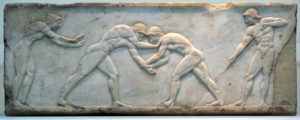
During the Middle Ages wrestling was popular, including in royal houses in France, Japan, and England. Much later, American settlers brought wresting traditions with them from England and discovered wrestling to be popular among the Native American tribes. During the early years of America’s development, amateur wresting was very popular, making appearances at county fairs, carnivals, holiday celebrations, and military exercises. Of the many styles practiced during that time, however, only the catch-as-catch-can survived, evolving into the style used today at the collegiate level. It is a combat sport involving grappling-type techniques such as clinch fighting, throws and takedowns, joint locks, pins and other grappling holds. The sport can either be theatrical for entertainment (see professional wrestling), or genuinely competitive. A wrestling bout is a physical competition, between two competitors or sparring partners, who attempt to gain and maintain a superior position. There are a wide range of styles with varying rules with both traditional historic and modern styles. Wrestling disciplines, as defined by UWW, are broken down into two categories; International wrestling disciplines and folk wrestling disciplines. UWW currently recognizes six wrestling disciplines in all. Three are Olympic disciplines: Greco-Roman wrestling, men’s freestyle wrestling and female wrestling (i.e. women’s freestyle wrestling).
Medieval and early Europe: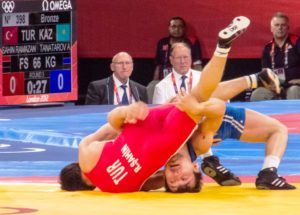
There is ample evidence of wrestling practiced throughout medieval Europe, both by the nobility and the lower classes. Wrestling remained popular during the Renaissance, and for much of the 16th century. In Henry VIII’s kingdom, wrestling in many places was widely popular and had a long history.
The German tradition has records of a number of master-Ringer of the 15th to 16th centuries specializing in unarmed combat. While sportive grappling had fixed rules that prohibited dangerous techniques, usually starting in grappling hold and ending with a throw or submission, ‘Kampfringen’ can be considered a system of unarmed self-defence including punches, joint-locks, elbow strikes, chokeholds, headbutts and (to a limited extent) kicks.
It was only with the beginning Early Modern period, specifically the more “dignified” code of behaviour the upper classes imposed on themselves in the Baroque period that wrestling was abandoned by European nobility, and it became a pastime of rural populations, developing into the various surviving forms of European folk wrestling.
 Middle East:
Middle East:
Many of the world’s oldest depictions of wrestling can be found in the Middle East. Carvings and statues show that forms of belt wrestling existed in the region since ancient times, in addition to matches between humans and animals. Wrestling is also mentioned in the epics of Gilgamesh and the Shahnameh. Oil wrestling as practiced in present-day Turkey and Central Asia is recorded in ancient Sumeria and Babylon. In Persia, Pahlavani traditional grappling or Koshti (کشتی) was practiced by both the upper and lower classes both for sport and as training for battle. In training halls known as zourkhaneh, soldiers practiced resistance exercises and grappling in a tradition now called Varzesh-e Bastani (ورزش باستانی; lit. “ancient athletics”). Ancient Iranian combat-wrestling included not only grabs but also punches and low kicks. As Iranian influence spread with the Achaemenid Empire and later the Persian Empire, the practice was adopted in the Indian subcontinent as Pehlwani.
The Great Gama of India: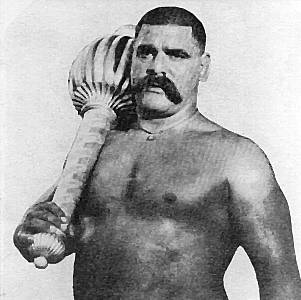
Ghulam Muhammad, also known as the ‘Great Gama’ and Gama Pehalwan was probably the greatest wrestler to ever walk the surface of the earth. Born in Amritsar, then in the Punjab Province of the British India, in 1878, he was awarded the Indian version of the World Heavyweight Championship on 15 October 1910 and went on to defeat free style wrestling champions across the world. Undefeated in a career spanning more than 52 years, he is considered one of the greatest wrestlers of all time. The legend of Gama Pehalwan was built in the mud pits and akharas of pre-independence rural India. Such was his fame and popularity that even Bruce Lee drew inspiration from him.
Gama’s daily training consisted of grappling with forty of his fellow wrestlers in the akhada (wrestling mud-pit). He did a minimum of five thousand baithaks (squats) and three thousand dands (push-ups) in a day and even sometimes more within 30 to 45 minutes each by wearing a doughnut-shaped wrestling device called a Hasli of 1 Quintal (nearabout 100 kilos).
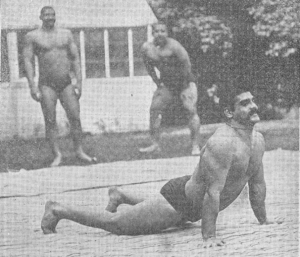
Have a sneak-peek to the diet of Gama-
10 litres of milk/day
One & Half pounds of crushed almond paste
Half litre of ghee
Six pounds of butter
Three buckets of seasonal fruits
Two desi muttons
Six desi chickens
Along with fruit juices
And other food-products filled with vitamins and minerals
Fame came to Gama in 1895, at the age of 17 when he challenged then-Indian Wrestling Champion, middle-aged Raheem Bakhsh Sultaniwala, another ethnic Kashmiri wrestler from Gujranwala, now in Punjab, Pakistan. At about 7 feet tall, with a very impressive win-loss record, Raheem was expected to easily defeat the 5’7″ Gama. Raheem’s only drawback was his age as he was much older than Gama, and near the end of his career. The bout continued for hours and eventually ended in a draw. The contest with Raheem was the turning point in Gama’s career. After that, he was looked upon as the next contender for the title of Rustam-e-Hind or the Indian Wrestling Championship. In the first bout Gama remained defensive, but in the second bout, Gama went on attacking. Despite severe bleeding from his nose and ears, he managed to deal out a great deal of damage to Raheem Bakhsh.
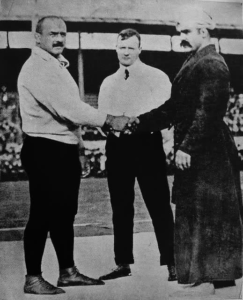
By 1910, Gama had defeated all the prominent Indian wrestlers who faced him except the champion, Raheem Bakhsh Sultani Wala (the Rustam-e-Hind or the lineal champion of India). At this time, he focused his attention on the rest of the world.
Bruce Lee was an avid follower of Gama’s training routine. Lee read articles about Gama and how he employed his exercises to build his legendary strength for wrestling, and Lee quickly incorporated them into his own routine. The training routines Lee used included “the cat stretch”, and “the squat”. Today, the doughnut-shaped exercise disc called Hasli weighing 100 kg, which he used for squats and push-ups, is housed at the National Institute of Sports (NIS) Museum at Patiala, India.
Principles & Practice:
Under FILA rules, contests of both international freestyle and Greco-Roman styles of touch-fall wrestling are similar, the object being in each case to throw or press the opponent on his back so that his shoulder blades touch the ground simultaneously. This need occurs only for an instant, but a continuous roll across the shoulders is not considered a fall.
The competitors meet on a large padded mat and commence by taking holds from a standing position. Their struggle is observed and controlled by officials, one of whom, the referee, stands on the mat with the wrestlers and signals the award of points for manoeuvres leading toward a touch-fall. If no fall occurs before the expiration of the match, these points are used to determine a winner. The actual match is continuous except that it is divided into three periods with a brief rest in between. Ties or draws are common in wrestling.
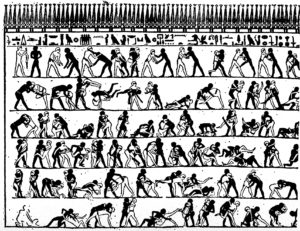
The competitors make use of techniques that are best learned by practice. While standing, they strive to bring each other to the mat with a series of manoeuvres known as takedowns, involving lifting, throwing, twisting, tackling, and tripping. When attacked, a wrestler applies counterattacks to convert the situation to his own advantage. If the wrestlers go down on the mat without a touch-fall, they proceed to grapple, seizing each other with various grips and counter grips to work toward a fall. Great strength, though an asset, is not a prerequisite, since most of the manoeuvres employ the principle of leverage; quickness and good physical condition are far more essential. The action in wrestling proceeds at a furious pace and involves all muscles of the body. The use of weight classes prevents the pairing of any two men with more than a few pounds difference between them.

Although the Spartans trained young girls as wrestlers in ancient Greece and an occasional female wrestler, if only legendary, such as Zenobia, has appeared, wrestling by women occurred in the 20th century only as a novelty spectacle.
Needless to say, wrestling is one of the oldest forms of systemized combat. Apart from the aforementioned cave drawings discovered in France dating back centuries, wrestling has also prominently figured in ancient literature.
Literary references to wrestling can even be found in the Bible’s Old Testament and the ancient Indian Vedas. The Iliad contains various references to wrestling, in which Homer mentions its use in the Trojan War. Indian tales the Ramayana and the Mahabharata contain multiple references to martial arts, which includes wrestling. Ancient Greece featured wrestling as the focal point of the ancient Olympic games.
Best place to learn:
Killer Kowalski’s Pro Wrestling School, North Andover, Massachusetts.
United World Wrestling operates several High-Performance training centres around the world.


How does the historical evolution of wrestling, from its ancient origins referenced in the Iliad and depicted in cave drawings, to its prominence in ancient Greece and incorporation into the Olympic Games, contribute to the development of modern wrestling styles such as Greco-Roman wrestling?